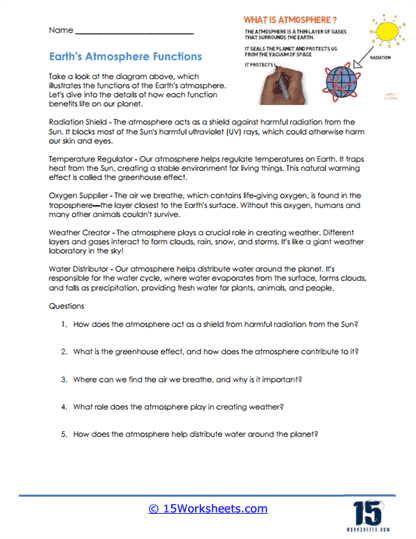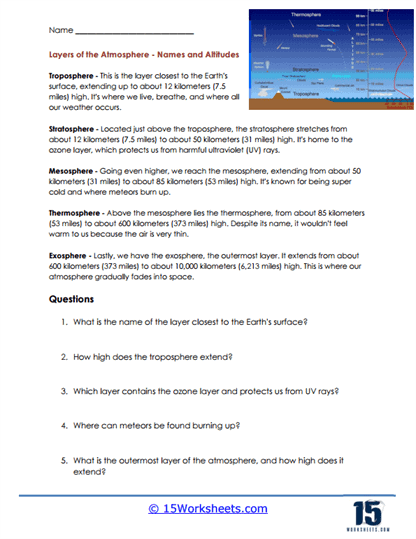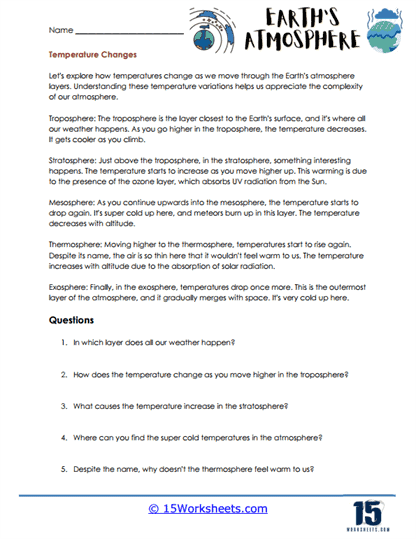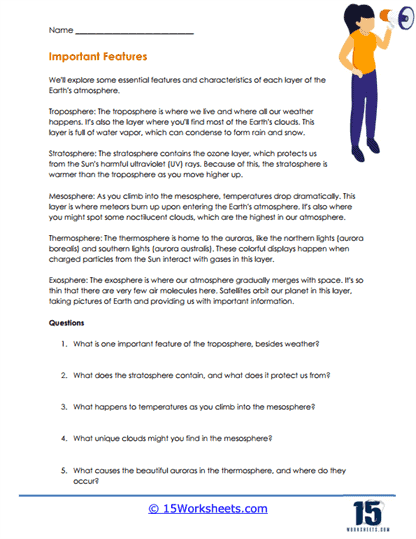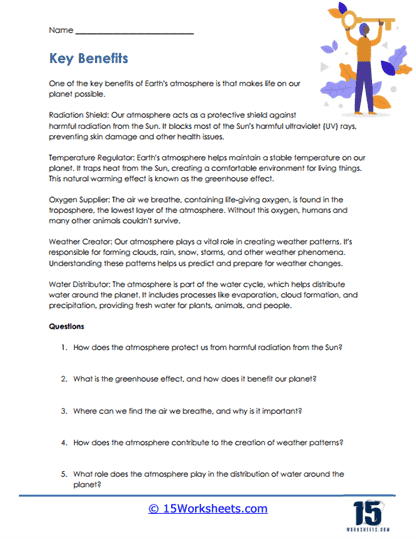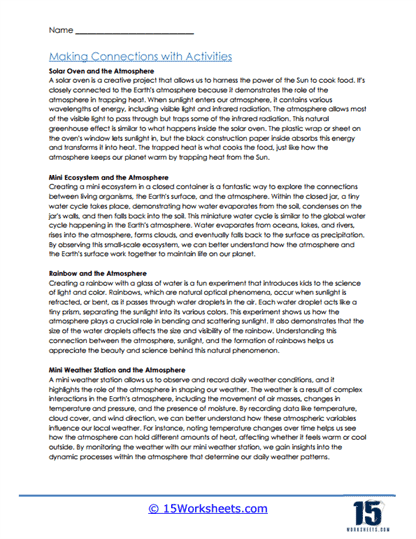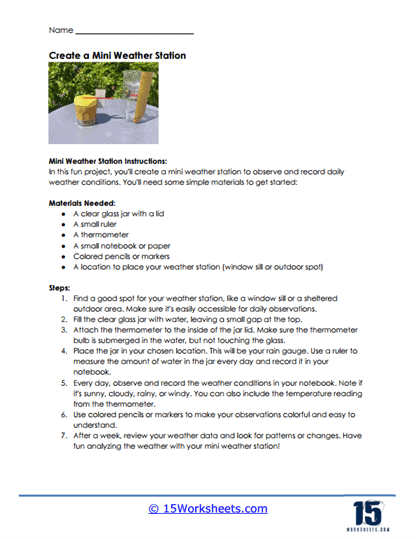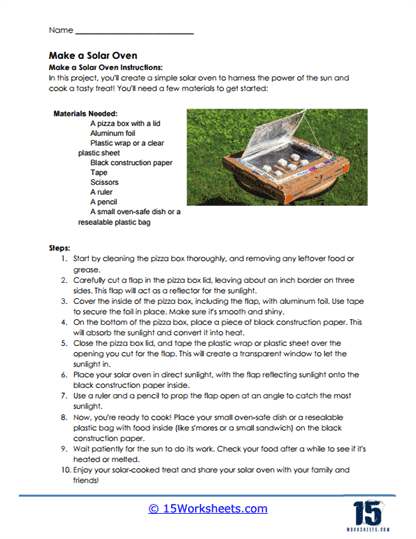Earth's Atmosphere Worksheets
About These 15 Worksheets
Earth’s Atmosphere Worksheets are sets of questions and activities designed to help you learn about the invisible blanket of gases that wrap around our planet. This “blanket” plays a vital role in supporting life and influencing the weather. Worksheets provide a structured way for you to learn and test your knowledge on this topic.
Earth’s atmosphere is a fascinating and essential part of our world. It provides us with the air we breathe, protects us from harmful solar radiation, and regulates our planet’s temperature. These worksheets will help you understand the depth and breadth of this subject. From multiple-choice questions to creative activities, these worksheets offer various ways for you to engage with and understand the topic. The next time you step outside and take a deep breath, remember the amazing atmospheric system that makes that simple act possible!
The importance of this topic cannot be overstated, as it equips students with knowledge that is not only relevant to their daily lives but also critical for addressing global challenges like climate change and environmental conservation. By studying Earth’s atmosphere, students gain insights into the factors driving weather patterns, climate variations, and the consequences of human activities on our planet. Furthermore, this collection fosters scientific literacy, critical thinking, and an appreciation for the interconnectedness of Earth’s systems. Ultimately, it empowers students to make informed decisions about environmental issues and to become responsible stewards of the planet, contributing to a sustainable future.
A Look At These Worksheets
The Earth’s atmosphere isn’t just a blanket of air-it’s a multilayered, life-preserving, occasionally moody force field. Students begin their journey through this atmospheric wonderland with worksheets like “Layers of the Atmosphere,” “More Layers,” “Top Down Atmosphere,” and “Names and Altitudes.” These introduce the atmospheric layers like characters in a dramatic soap opera: the troposphere brings all the weather chaos, the stratosphere flexes its ozone muscle, and the exosphere just kind of floats off dramatically. Through diagrams, matching tasks, and altitude charting, students gain a clear-and sometimes hilariously illustrated-map of the sky above. The real insight? Realizing that Earth’s whole weather system fits into a shockingly thin slice of air.
With that solid foundation, students move on to what the atmosphere actually does for us. Worksheets like “Atmosphere Functions,” “Important Features,” and “Key Benefits” explore its superpowers: filtering deadly radiation, trapping just the right amount of heat, and gifting us breathable air (a small but vital detail). These activities challenge students to think critically about invisible processes-transforming them into guardians of gases and defenders of diffusion. Humor shows up in examples like space rocks getting vaporized before they ruin someone’s day. The deeper thought kicks in when students recognize how much we take this protective sky-shield for granted.
Next, the worksheets ask students to look inward-or maybe just downward-at how we treat our atmosphere. “Protecting Earth,” “Making Connections with Activities,” and “Greenhouse Effect and Global Warming” zoom in on environmental responsibility. Students explore how pollution, deforestation, and excessive cow burps contribute to the planet’s slow warming, while simultaneously offering hope through simple changes. Think of it as eco-guilt balanced with action items. These worksheets encourage students not just to learn, but to care-because even young minds can influence big things, especially when they realize Earth’s thermostat is a bit twitchy.
From there, the curriculum dives deep into heat and climate with “The Greenhouse Effect” and “Temperature Changes.” Here, students become mini meteorologists, tracing the journey of sunlight as it warms the Earth and bounces back-sometimes trapped by greenhouse gases like an awkward party guest who won’t leave. Graphs, heat maps, and cause-effect puzzles guide learners to understand how even a tiny atmospheric change can nudge global temperatures. There’s humor in comparing CO₂ to clingy blankets, but the real moment of truth arrives when they realize that global warming isn’t just a buzzword-it’s physics in action.
To bring science to life (and possibly to the kitchen counter), the collection rolls out hands-on projects like “Create a Mini Weather Station,” “Make a Solar Oven,” and “Create a Mini Ecosystem.” These worksheets encourage students to stop observing and start experimenting. They build rain gauges from old bottles, harness the sun to cook s’mores (delicious science), and craft little ecosystems that mimic the balance of nature. Things might get messy-especially when humidity meets glitter-but students learn through experience that science isn’t just something you read about. It’s something you do, sometimes with sticky fingers and sunburnt marshmallows.
The learning journey closes with a moment of wonder: “Make a Rainbow with a Glass of Water.” It’s a simple act-bending light with a glass-and yet it ties together everything students have learned: layers of atmosphere, the role of sunlight, the dance of water and air. It ends on a poetic note, reminding students that science isn’t only about graphs and greenhouse gases. It’s also about beauty. This worksheet acts like a final bow from the atmosphere itself, saying: “You’ve learned how I work-now go see the colors I can make.”
What is Earth’s Atmosphere?
Earth’s atmosphere is a thin layer of gases that envelops our planet. It plays several crucial roles that make Earth hospitable for life as we know it. Let’s dive into its purpose and the various layers that make it up.
Purpose
Provides Breathable Air – The atmosphere gives us oxygen to breathe and takes away carbon dioxide, which is a waste product of respiration.
Protection – It protects us from harmful ultraviolet (UV) radiation from the sun. The ozone layer, specifically, absorbs most of these rays.
Temperature Regulation – The atmosphere acts as a blanket, trapping some of the sun’s warmth, which is essential in keeping Earth’s temperatures stable and suitable for life. This is known as the greenhouse effect.
Meteoroid Protection – Small meteoroids often disintegrate in the atmosphere before they can reach the Earth’s surface.
Weather and Climate – It plays a central role in the water cycle, which includes processes like evaporation, condensation, and precipitation, thus influencing the weather and climate.
Layers of the Earth’s Atmosphere
1. Troposphere
Height – 0 to 8 km (at the poles) to 0 to 18 km (at the equator)
This layer is where we live, and it contains about 75% of the atmosphere’s mass and 99% of its water vapor. Weather phenomena like rain, snow, and storms occur here. The temperature decreases as you go higher in the troposphere.
2. Stratosphere
Height – About 8 to 50 km
The ozone layer, which absorbs and scatters the sun’s UV radiation, is in this layer. Interestingly, unlike the troposphere, the temperature increases as you move higher up in the stratosphere, primarily because of the ozone layer’s absorption of UV rays.
3. Mesosphere
Height – About 50 to 85 km
This is the coldest layer of our atmosphere, with temperatures falling as low as -90°C (-130°F). Most meteoroids burn up in the mesosphere, creating “shooting stars.”
4. Thermosphere
Height – About 85 to 600 km
This layer is characterized by high temperatures, which can climb thousands of degrees. However, if we were in the thermosphere, we would still feel cold due to the extremely low pressure and density. The auroras, Northern and Southern Lights, occur in this layer.
5. Exosphere
Height – Above 600 km
This is the outermost layer of our atmosphere, where atoms and molecules escape into space. The exosphere blends into the void of outer space and has very low density.





